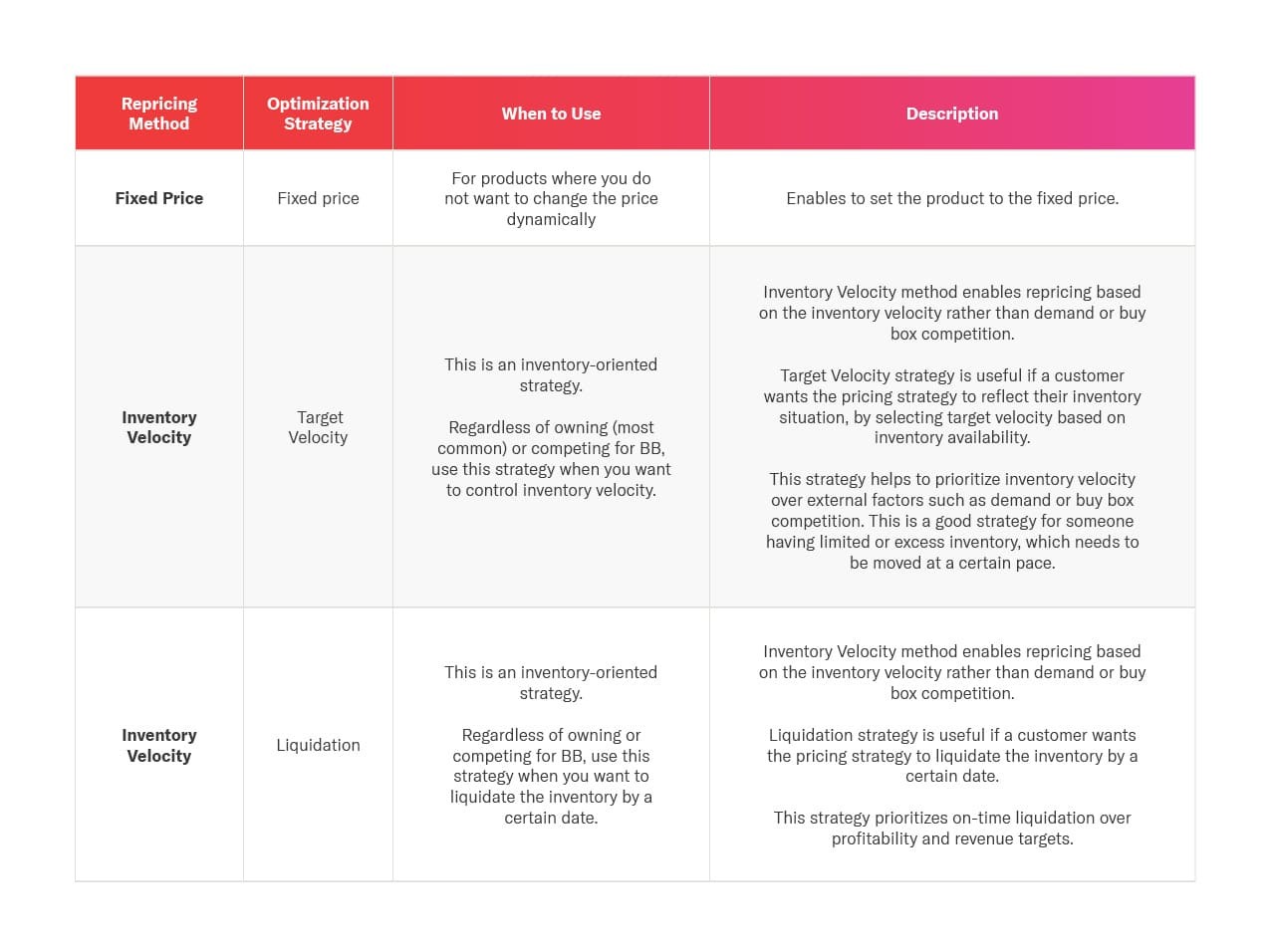Resources
Repricer Slider Updates
Repricing Methods and Strategies Explained
Repricing Methods and Strategies are now at the top of the slider, allowing you to easily adjust your strategies according to your goals. Learn more about Repricing Strategies at the end of this article.
Advanced Section of Slider Merchant-Based Behaviors, Stop Loss Features, and Catalog Details
- Turn on “Merchant-Based Behaviors” to see how your price compares to Amazon’s
- Why This Matters: Amazon is the largest competitor for many, and knowing what they are doing will ensure your prices are competitive to theirs.
- Learn more about the Merchant Behaviors Feature here
- New Stop Loss Capabilities in Market Conditions Section
- Why This Matters -> Gives you greater control on price iterations and events, by allowing you to limit the amount in which the algorithm moves the price of your product.
- Learn more about the Stop Loss Feature here
- Catalog now has its own section at the top.
- Why This Matters: You can easily populate all tagging information, such as vendor, brand, parent SKU, unit SKU, etc., for greater inventory control.
Non-Competitive Items Updates Follow a Competitor and Toggle Back to Buy Box Repricer
- Greater Competitive Insights for Non-Competitive Items Such as Private Label and Exclusive Listings
- Why This Matters: With our New PSP Slider, users can now follow their competition to make faster strategic changes AND easily toggle back to the Buy Box Repricer if there is competition
New Configuration and Listing File
Repricing Strategies Explained

Use Profit Optimization when competing for the Buy Box.
This enables you to win the buy box at the optimal price, such that will yield the maximum overall profit.
This optimization strategy is capable to assess the tradeoff between the sales velocity and margin at every repricing iteration and uses this assessment to determine the optimal price point.
This strategy is the best default strategy when competing for the BB.
Use Dominate the BB when competing for the Buy Box.
This strategy enables targeting of nearly 100% of the buy box.
Obviously, dominating the buy box comes from an aggressive price action and often comes at the expense of the profit margin.
This strategy fits sellers whose approach is to prevent competitors from winning the buy box and require a strong pricing power.
Use Target Buy Box Share when competing for the Buy Box.
Target BB Share is a strategy that enables sellers to explicitly target a particular buy box share.
It is useful in cases where a seller wants to spit the buy box with competitors in a particular way.
Unless there is a special importance of achieving a particular buy box share, the sellers will be better off by optimizing for profit or for buy box domination. This is because of the complex tradeoff between the price (profit margin) and competition (buy box share), which changes based on the market conditions.
ProductSphere Strategies

Use Profit Optimization when you own the Buy Box.
ProductSphere method enable optimizing pricing for the overall demand. The ProductSphere algorithms look at the multiple factors such as competition, discoverability, seasonality and consumer demand, to build dynamic demand curves.
Profit Optimization strategy enables targeting price optimization that yields optimal overall profit.
Use Revenue Optimization when you own the Buy Box.
ProductSphere method enable optimizing pricing for the overall demand. The ProductSphere algorithms look at the multiple factors such as competition, discoverability, seasonality and consumer demand, to build dynamic demand curves.
Revenue Optimization strategy enables targeting price optimization that yields optimal overall sales.
Use Follow Competitor when you own the Buy Box.
This strategy enables to tag price to a particular competitor product in a certain ratio and will update the price when the competitor price changes.
Fixed Price and Inventory Strategies

Use Fixed Price for products where you do not want to change the price dynamically.
Enables to set the product to the fixed price.
Use Taret Velocity regardless of owning (most common) or competing for BB, use this strategy when you want to control inventory velocity.
Inventory Velocity method enables repricing based on the inventory velocity rather than demand or buy box competition.
Target Velocity strategy is useful if a customer wants the pricing strategy to reflect their inventory situation, by selecting target velocity based on inventory availability.
This strategy helps to prioritize inventory velocity over external factors such as demand or buy box competition. This is a good strategy for someone having limited or excess inventory, which needs to be moved at a certain pace.
Use Liquidation regardless of owning or competing for BB, use this strategy when you want to liquidate the inventory by a certain date.
Inventory Velocity method enables repricing based on the inventory velocity rather than demand or buy box competition.
Liquidation strategy is useful if a customer wants the pricing strategy to liquidate the inventory by a certain date.
This strategy prioritizes on-time liquidation over profitability and revenue targets.

